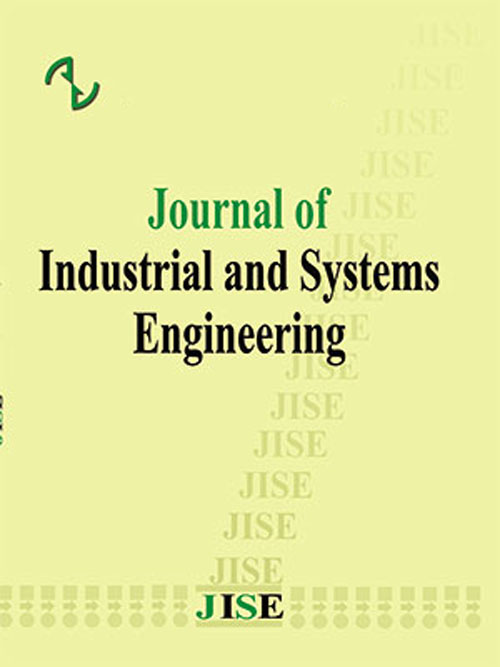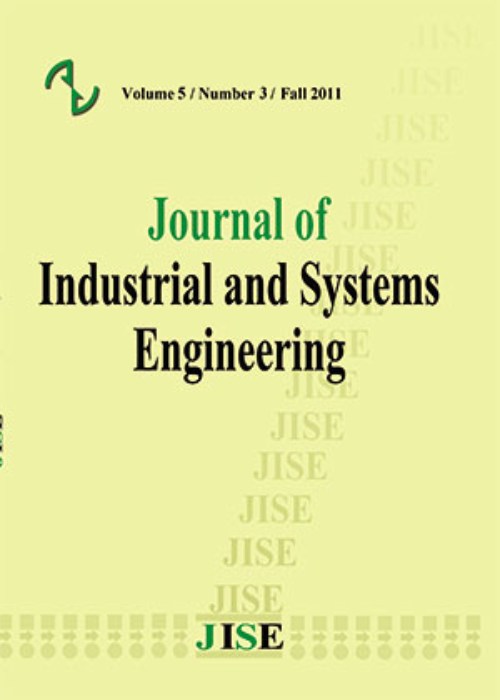فهرست مطالب

Journal of Industrial and Systems Engineering
Volume:10 Issue: 2, Spring 2017
- تاریخ انتشار: 1396/03/21
- تعداد عناوین: 9
-
-
Pages 1-24In this paper, real options theory is utilized to evaluate the effect of uncertain electricity and CO2 costs on speculation conduct. Methodologically, the allegiance of the newspaper in this appreciation is that uncertainty is not just stopped down as far as stochastic processes and their fluctuation, additionally as far as expected and acknowledged procedures, i.e. the procedures, which are used as a constituent of the progression system, and the processes that the speculator really confronts when picking the choices as per his ideal methodology. We utilize the components of portfolio theory and consolidate them in a vintage setting, keeping in mind the end goal to conquer the lack of it and advantage from that focal point, while as yet having the capacity to think about element portfolios. The idea is to not just discover portfolios that augment returns subject to a predefined level of danger or the other way around keeping in mind the end goal to place the ideal system of innovations at a period in time, yet to decide the ideal means of advancement of such a portfolio after some time, given changing information costs and continuous mechanical advancement and exposure about these processes. In other words, we locate the ideal portfolio over advancements, as well as crosswise over time and quality.Keywords: Energy planning, Sustainability, real options theory, portfolio theory
-
Pages 25-34Recently, a mixed integer data envelopment analysis (DEA) model has been proposed to find the most BCC-efficient (or the best) decision making unit (DMU) by Toloo (2012). This paper shows that the model may be infeasible in some cases, and when the model is feasible, it may fail to identify the most efficient DMU, correctly. We develop an improved model to find the most BCC-efficient DMU that removes the mentioned drawbacks. Also, an algorithm is proposed to find and rank other most BCC-efficient DMUs, when there exist more than one BCC-efficient DMUs. The capability and usefulness of the proposed model are indicated, using a real data set of nineteen facility layout designs (FLDs) and twelve flexible manufacturing systems (FMSs).Keywords: data envelopment analysis (DEA), most BCC-efficient DMU, mixed integer DEA models, Ranking, facility layout design
-
Pages 35-52Vehicle routing problem is one of the most important issues in transportation. Among VRP problems, the competitive VRP is more important because there is a tough competition between distributors and retailers. In this study we introduced new method for VRP in competitive environment. In these methods Two-Person Nonzero Sum games are defined to choose equilibrium solution. Therefore, revenue given in each route is different. In this paper, two distributors has been considered in a city with a set of customers and the best route with maximum revenue has been determined. First we introduced the Hawk-Dove procedure for the VRP problem and then by using Nash bargaining model the equilibrium strategy of the game is calculated. The result of this method is different based on the kind of the strategy that each distributor chooses. In the Hawk-Dove game, if both of distributors choose the Dove procedure, they will get equal but less revenue. In the Nash Bargaining Game, the equilibrium strategy will obtained when distance of revenues of both distributors form its breakdown payoff is maximum.Keywords: vehicle routing problem, two-person nonzero sum game, Hawk-Dove game, Nash bargaining game, equilibrium solution
-
Pages 53-74This paper considers advertising, collection and pricing decisions simultaneously for a closed-loop supplychain(CLSC) with one manufacturer(he) and two retailers(she). A multiplicatively separable new demand function is proposed which influenced by pricing and advertising. In this paper, three well-known scenarios in the game theory including the Nash, Stackelberg and Cooperative games are exploited to study the effects of pricing, advertising and collection decisions on the CLSC. Using these scenarios, we identify optimal decisions in each case for the manufacture and retailers. Extending the Manufacturer-Stackelbergscenario, we introduce the manufacturers risk-averse behavior in a leaderfollower type move under asymmetric information, focusing specifically on how the risk-averse behavior of the manufacturer influences all of the optimal decisions and construct manufacturer-Stackelberg games in which each retailer has more information regarding the market size than the manufacturer and another retailer. Under the meanvariance decision framework, we develop a closed-loop supply chain model and obtain the optimal equilibrium results. In the situation of the stackelberg game, we find that whether utility of the manufacturer is better off or worse off depends on the manufacturers return rate and the degree of risk aversion under asymmetric and symmetric information structures. Numerical experiments compare the outcomes of decisions and profits among the mentioned games in order to study the application of the models.Keywords: Closed-loop supply chain (CLSC), Game Theory, advertising, pricing, Asymmetric information, risk-averse behavior
-
Pages 75-86Transportation sector generates a considerable part of each nation's gross domestic product and considered among the largest consumers of oil products in the world. This paper proposes a heuristic method for the vehicle routing problem with hard time windows while incorporating the costs of fuel, driver, and vehicle. The proposed heuristic uses a novel speed optimization algorithm to reach its objectives. Performance of the proposed algorithm is validated by comparing its results with the results of the exact method and differential evaluation algorithm for small-scale problems. For large-scale problems, the results of the proposed algorithm are compared with those obtained from the differential evaluation algorithm. Overall, results indicate the good performance of the proposed heuristic algorithm.Keywords: Microscopic emission models, Vehicle routing with hard time windows, PFIH algorithm, Differential evolution algorithm
-
Pages 87-112This paper investigates the integration of strategic and tactical decisions in the supply chain network design (SCND) considering assembly line balancing (ALB) under demand uncertainty. Due to the decentralized decisions, a novel bi-level stochastic programming (BLSP) model has been developed in which SCND problem has been considered in the upper-level model, while the lower-level model contains ALB problem as a tactical decision in the assemblers of supply chain network. To deal with demand uncertainty, a scenario generation algorithm has been proposed within the stochastic optimization model that combines time series model, Latin hypercube sampling method and backward scenario reduction technique. In addition based on the special structure of the model, a heuristic-based solution method is proposed to solve the developed BLSP model. Finally, computational experiments on several problem instances are presented to show the performance of the model and its solution method. The comparison between the stochastic and equivalent deterministic model demonstrated that the developed stochastic model mainly performs better than the deterministic model especially in making strategic decisions while the deterministic model works better in making tactical decisions.Keywords: Bi-level stochastic programming, Supply chain network design, scenario-based approach, assembly line balancing, uncertain demand
-
Pages 113-133Supplier selection is one the main concern in the context of supply chain networks by considering their global and competitive features. Resilient supplier selection as generally new idea has not been addressed properly in the literature under uncertain conditions. Therefore, in this paper, a new multi-criteria group decision-making (MCGDM) model is introduced with interval-valued fuzzy sets (IVFSs) and fuzzy possibilistic statistical concepts. Then, a new weighting method for the supply chain experts or decision makers (DMs) is presented under uncertainty in supply chain networks. Additionally, a modified version of an entropy method is extended for computing the weight of each assessment criterion. Possibilistic mean, standard deviation, and the cube-root of skewness are proposed within the MCGDM. In addition, a new fuzzy ranking method based on relative-closeness coefficients are proposed to rank the resilient supplier candidates. Finally, a resilient supplier selection problem is solved by the proposed group decision model to demonstrate its validity and is compared with a recent study.Keywords: Resilient supplier selection, interval-valued fuzzy sets, possibilistic statistics, Supply Chain Management, multi-criteria group decision making
-
Pages 134-150Data envelopment analysis (DEA) is an approach to measure the relative efficiency of decision-making units with multiple inputs and multiple outputs using mathematical programming. In the traditional DEA, it is assumed that we know the input or output role of each performance measure. But in some situations, the type of performance measure is unknown. These performance measures are called flexible measures. In addition, the traditional DEA needs crisp input and output data which may not always be available in real world applications. This paper discusses the input or output role of flexible measures using the DEA in environments with interval inputs and outputs. The application of the proposed DEA models is shown with a real dataset.Keywords: Data envelopment analysis, interval data, flexible measures
-
Pages 151-168This paper studies a decentralized supply chain in which a manufacturer sells a common generic product through two traditional and online retailers under free riding market. We assume that the traditional retailer provides the value added services but the online retailer does not. Factors such as retail prices, local advertising of the retailers, global advertising of the manufacturer and service level of the traditional retailer simultaneously has effect on market demand. This paper studies the cost information sharing between the manufacturer and traditional retailer and uses the cooperative advertising program as an incentive mechanism for information sharing under free riding. This paper also examines how the free riding phenomenon affects the information sharing between the manufacturer and traditional retailer and also the supply chain coordination. Our analysis shows that, through the cooperative advertising program, information sharing between the manufacturer and traditional retailer is always beneficial for all the supply chain members and therefore, the entire supply chain is coordinated except when the traditional retailer is not efficient and the degree of free riding is relatively small.Keywords: Supply chain coordination, information sharing, vertical cooperative advertising, online shopping, free riding, Game Theory


